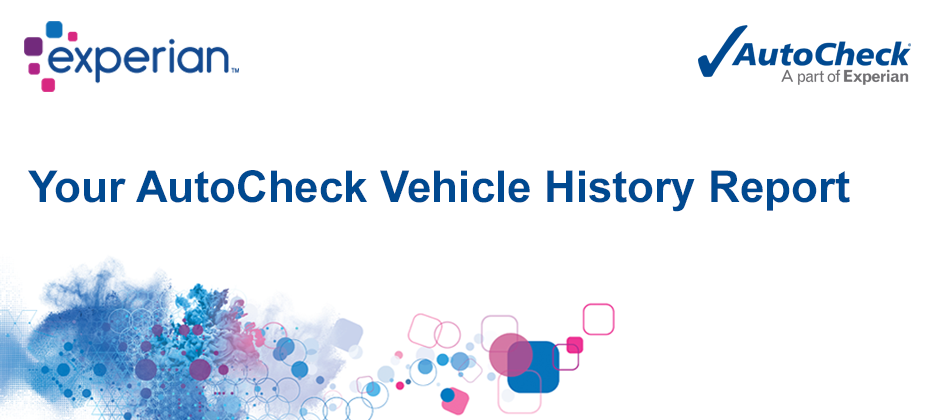Tag: used-vehicles

Experian's Q4 2020 State of the Automotive Finance Market report gives insight into the current state of the leasing market.

According to Experian’s Q3 2020 State of the Automotive Finance Market report, 26.20% of all new vehicles are leased compared to 30.27% last year.

When we think about vehicle history, we tend to imagine two audiences: dealers and consumers. After all, identifying any potential hidden defects could have a significant impact on a used car buying decision; vehicle history reports are an invaluable part of the process. But it’s not just dealers and consumers who can benefit. It takes three things to sell a vehicle: the car (dealers), the consumer and credit; we’ve covered the first two, so let’s focus on the third. Lenders take a plethora of information into consideration when making automotive lending decisions, including a borrower’s credit score, payment history and utilization rate. But these data points only reflect the risk associated with the borrower; there’s also inherent risk with the vehicle itself. I recently participated in a virtual workshop, The Risky Side of the Road, during Used Car Week 2020, where we discussed the value of leveraging vehicle history information to minimize risk with lending decisions. Extending a loan to a borrower hoping to purchase a used vehicle with unidentified defects exposes the lender to unnecessary risk; hidden damage and maintenance costs could impact a borrower’s ability to repay the loan. To minimize portfolio risk, we recommend lenders leverage vehicle history reports, such as AutoCheck, before making a lending decision. Hidden Damage Significantly Impacts Vehicle Value Let’s consider the universe of used vehicles that could potentially be sold and financed. According to Experian’s Q2 2020 Market Trends Review, there are more than 280 million vehicles on the road. And our research indicates that four out of 10 of the cars and light duty trucks on the road have been in at least one accident, and around 20% of vehicles have been in multiple accidents. What does this mean for a vehicle’s value? Even if a vehicle has been completely restored and repaired, the value of the vehicle diminishes. According to a recent Mitchell Industry Trends Physical Damage Report, in Q2 2019, the average diminished value for a vehicle involved in an accident was $3,151; and this doesn’t include the fiscal impact of other hidden defects, such as flood damage. And the loss in value trickles down to the consumer and lender. For instance, if a lender unknowingly extends a $10,000 loan to a consumer who purchases a used vehicle that was involved in an accident, the actual value of the vehicle may be around $7,000. If the consumer decides to sell the vehicle before paying off the loan, it is very likely they will be up-side down. If the consumer falls behind on payments and the vehicle is repossessed, it will be difficult for the lender to recoup any losses at auction. But that’s where vehicle history reports come into play. Tools, such as AutoCheck vehicle history reports, inform lenders about reported accidents and recall information, among other insights. In addition, the AutoCheck Score, enables users to compare a vehicle with vehicles of similar class and age and assess the likelihood it will be on the road in five years. The AutoCheck Score can also help gauge the value and drivability of a repossessed vehicle. For example, according to Experian’s similarly titled white paper, The Risky Side of the Road, we found that the percentage of repossessed vehicles that were drivable was higher for vehicles assured by AutoCheck vehicle history reports (86.16%) versus those that were not assured (80.75%). Additionally, we found that repossessed vehicles that were drivable tend to have higher AutoCheck Score range. And unsurprisingly, vehicles that are drivable tend to perform better at auction, meaning a better return on investment for the lender. During these uncertain times, it is important for lenders to more precisely gauge the level of risk they take on. The more information lenders have about the used vehicles they are financing, the better positioned they will be to offer loan terms that minimize portfolio risk, while better meeting consumer needs. To view Experian’s white paper, The Risky Side of the Road, click here.

According to Experian’s Q3 2019 State of the Automotive Finance Market report, used vehicle financing increased across all credit tiers.

Introducing the newly designed AutoCheck Score™ Quickly compare and select used vehicles As an auto industry professional, you use vehicle history reports every day. But they’re long, complex — easily misinterpreted. You always aim to conduct a thorough inspection. But what if you’re at a busy auction house or browsing online, where there’s simply not enough time or context? The tool you use every day to make critical decisions about used vehicles should be accurate and easy to understand — built for streamlined evaluation. So we made one. New look, same impact We’ve revamped the AutoCheck score with a modern look and feel that’s easier than ever to read. And it’s still invaluable for quickly comparing and selecting used vehicles. What, exactly, is it? Experian® analyzes the detailed records in an AutoCheck® vehicle history report to generate the AutoCheck Score. Like a credit score or gas mileage rating for new vehicles, it’s a single number on a standardized scale. The new gauge shows the score range (from 1 - 100) for vehicles of similar age in the same class. If a car is above average in its range, you can feel confident that it’s a solid investment. The score makes it much simpler to assess how a used vehicle measures up, estimating its: Overall roadworthiness Reliability compared to other vehicles in its class Likelihood of being on the road in five years It is invaluable for making informed decisions, managing inventory, mitigating risk and instilling confidence in customers. Bigger, better You can depend on the AutoCheck Score to deliver a high-quality, more accurate assessment. That’s because it’s derived from Experian’s world-class, continually updated database, which leverages reliable information from extensive sources, including: Tens of thousands of distinct accident sources, many exclusive to Experian 95% of U.S. auction houses — most providing structural damage, salvage-and-junk and export-data announcements exclusively to Experian Important OEM safety and open recall data State departments of motor vehicles and departments of public safety, insurance companies and other independent sources Police department/state agency accident information from all 50 states and Washington D.C. Federal sources, like import records That’s a lot of data. And some complex statistical modeling. Don’t worry; we’ll take care of the heavy lifting. All you have to do is keep score. Why you need it Whether you’re a dealer, lender, manufacturer certified pre-owned program or consumer portal, the score will transform the way you do business to boost your bottom line. Dealers: Use the score to mitigate risk, manage and market your inventory, close sales faster and build customer loyalty. Lenders/Credit Unions: Use the score to more accurately estimate a vehicle’s value at every stage of the loan life cycle, from origination to portfolio review, account management and asset collection. Manufacturer Certified Pre-Owned Programs: Use the AutoCheck report for vehicle certification. Consumer Portals: Increase customer satisfaction — and traffic — by allowing OEMs and dealers to post the score with their listings and make online car shopping a breeze. Count on the AutoCheck Score To learn more about the score — or how to wield its power to maximal effect — find its secrets in this treasure trove of a white paper or call 1 888 675 5596. What are you waiting for? Redesign your business with the redesigned score.

Vehicle affordability has been a main topic of conversation in the auto industry for some time, and based on the data, it’s not going unnoticed by consumers. The average new vehicle loan in Q1 2019 reached $32,187, while the average new vehicle monthly loan payment hit $554. How are car shoppers reacting? Perhaps the biggest shift in Q1 2019 was the growth of prime and super prime customers opting for used vehicles. The percentage of prime (61.88 percent) and super-prime (44.78 percent) consumers choosing used vehicles reached an all-time high in Q1 2019, according to Experian data. Not only are we seeing new payment amounts increase, but used loan amounts and payments are on the rise as well, though the delta between the two can be one of the reason we’re seeing more prime and super prime opt for used. The average used vehicle loan was slightly above $20,000 in Q1 2019, while the average used vehicle payment was $391. We know that consumers often shop based on the monthly payment amount, and given the $163 difference between average monthly payments for new and used, it’s not surprising to see more people opt for used vehicles. Another way that consumers can look to have a smaller payment amount is through leasing. We’re continuing to see that the top vehicles leased are more expensive CUVs, trucks and SUVs, which are pricier vehicles to purchase. But with the average lease payment being $457 per month, there’s an average difference of $97 compared to loan payments. In Q1 2019, leasing was down slightly year-over-year, but still accounted for 29.07 percent of all vehicle financing. On the other side of the affordability equation, beyond cost of vehicles, is concern around delinquencies: will consumers be able to make their payments in a timely manner? So far, so good. In Q1 2019, 30-day delinquencies saw an increase to 1.98 percent, up from 1.9 percent a year ago. That said, banks, credit unions and finance companies all saw slight decreases in 30-day delinquency rates, and 60-day delinquencies remained relatively stable at 0.68 percent year-over-year. It’s important to keep in mind that the 30-day delinquency rate is still well-below the high-water mark in Q1 2009 (2.81 percent). The vehicle finance market appears to remain strong overall, despite rising vehicle costs, loan amounts and monthly payments. Expect consumers to continue to find ways to minimize monthly payments. This could continue the shift into used vehicles. Overall, as long as delinquencies stay flat and vehicle sales don’t taper too badly, the auto finance market should stay on a positive course. To watch the full Q1 2019 State of the Automotive Finance Market webinar, click here.

Subprime originations hit the lowest overall share of the market seen in 11 years, but does that mean people are being locked out car ownership? Not necessarily, according to the Q3 State of the Automotive Finance Market report.To gain accurate insights from the vast amount of data available, it’s important to look at the entire picture that is created by the data. The decrease in subprime originations is due to many factors, one of which being that credit scores are increasing across the board (average is now 717 for new and 661 for used), which naturally shifts more consumers into the higher credit tiers. Loan origination market share are just one of the trends seen in this quarter’s report. Ultimately, examining the data can help inform lenders and help them make the right lending decisions. Exploring options for affordability While consumers analyze different possibilities to ensure their monthly payments are affordable, leasing is one of the more reasonable options in terms of monthly payments. In fact, the difference between the average new lease payment and new car payment usually averages more $100—and sometimes well over—which is a significant amount for the average American budget. In fact, leases of new vehicles are hovering around 30 percent, which is one of the factors that is aiding in new car sales. In turn, this then helps the used-vehicle market, as the high number of leases create a larger supply of quality use vehicles when they come off-lease and make their way back into the market. On-time payments continue to improve As consumer preferences continue to trend towards more expensive vehicles, such as crossovers, SUVs, and pickups, affordability will continue to be a topic of discussion. But consumers appear to be managing the higher prices, as in addition to the tactics mentioned above, 30- and 60-day delinquency rates declined since Q3 2017, from 2.39 percent to 2.23 percent and 0.76 percent to 0.72 percent, respectively. The automotive finance market is one where the old saying “no news is good news” continues to remain true. While there aren’t significant changes in the numbers quarter over quarter, this signals that the market is at a good place in its cycle. To learn more about the State of the Automotive Finance Market report, or to watch the webinar, click here.
